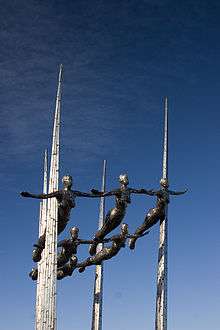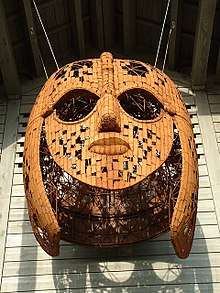Rick Kirby
Rick Kirby (born 1952) is an English sculptor born in Gillingham, Kent.[1] He started his career as an art teacher, before quitting after sixteen years to focus on his work. Much of his work is figural, reflecting an interest in the human face and form, and is primarily in steel, which he describes as giving a scale and "whoom-factor" not possible with other media.

Early life and education
Kirby was born in 1952 into a naval family.[2] He was interested in art as a child, and went on to study it after high school.[3] From 1969 to 1970 he studied at the Somerset College of Art, and from 1970 to 1973 at the Newport College Of Art, from which he received a Bachelor of Fine Arts.[3][4] This education was both liberating and confusing, he said, and left him without an idea for the direction of his work.[3] From 1973 to 1974 he therefore studied towards an Art Teacher's Diploma at the University of Birmingham,[3][4] and spent the next sixteen years teaching art.[3]
During his time as a teacher Kirby's own artistic sense bent towards sculpture, and after sixteen years he quit teaching to focus on his work.[3] For the next three years he sculpted in stone, before a steel-working co-tenant asked him to try out his welder.[3] "Steel released me", Kirby said. "It gave me the ability to go huge, a scale that just is not possible with stone": a "whoom-factor!"[3] As he described it, "it is the juxtaposition of steel in its raw form, cold-industrial, and the warm-human that my art breathes into it – that is my fascination."[5]
Work
Kirby's oeuvre is largely figural,[2] reflecting a fascination with the human face and form that has persisted since his time working in stone.[3] Though he uses an industrial medium in steel, Kirby's pieces are intended to express elegance and grace, and guardianship; a reviewer of one of his exhibitions noted that "they do not dominate their settings, but instead calmly watch over their environment with an air of gentle theatricality."[6]
Most of Kirby's pieces are public commissions, and are therefore monumental in size.[6] His pieces range in height from one to ten metres; his 2002 sculpture Sutton Hoo Helmet, modelled after the Anglo-Saxon Sutton Hoo helmet from the Sutton Hoo ship-burial and unveiled by Nobel laureate Seamus Heaney, is 1.8 metres (5 ft 11 in) tall and 1.6 metres (5 ft 3 in) deep,[7] and weighs 900 kilograms (2,000 lb).[8]
Several of Kirby's pieces are displayed in the Palace of Westminster in London, and in Putney along the banks of the River Thames.[2] His works have been unveiled by Queen Elizabeth II,[2][9] Princess Margaret, and Prince Edward.[10] When unveiling When the Sky's the Limit the Spirits Soar in 2005, Prince Edward remarked that "I don't know quite what the word is. It seems to represent something going upwards."[11]
Notable commissions

- Crouching Lady in Bardon Mill, 1997
- The Ring of Hope in the Gardens of Gaia, 1997[12]
- Figure in Middle of Lake in the Gardens of Gaia, 1997[12]
- Public sculpture in Castlemilk, Glasgow, as part of the district's Gateways and Landmarks project in 1999 (Kirby's first Bronze)
- Cross the Divide at the Main Entrance of St Thomas' Hospital, London, 2000
- Sutton Hoo Helmet (pictured at right), Sutton Hoo exhibition hall, Suffolk, 2002[7]
- Arc of Angels at Portishead, 2002, commemorating Portishead Radio Station[13][14][15]
- Formation (pictured above) in Ravenswood, Ipswich, 2003
- Spiral Formation for South Woodham Ferrers Leisure Centre swimming pool, 2005[16]
- When the Sky's the Limit the Spirits Soar, 2005[11]
- The Face at Wigan, 2008[17][18]
- Crouching Figure, Oakley Court Hotel, Windsor, 2012[5]
- Hands, Woodbridge Quay Church, Suffolk, 2016[19][20][21]
- 20th Century Head with others in the sculpture garden at Burghley House, Stamford
References
- Hong Kong Art Tutoring 2013.
- Bath Contemporary.
- ArtParkS.
- Rick Kirby cv.
- Marcelle Joseph 2012.
- Hope 2017, p. 44.
- Cocke 2009.
- Ipswich Star 2002.
- Wiltshire Gazette & Herald 2002.
- Axle Arts 2015.
- Morton 2005.
- Hoggard 2000.
- Lonsdale 2002.
- The Independent 2002.
- Public Art Port Marine.
- Essex Chronicle Series 2005.
- Qureshi, Yakub (19 April 2010). "Wigan's angel of the north". Retrieved 2 February 2018.
- The Times 2008.
- Cornwell 2017.
- Woodbridge Quay Church.
- Quality of Place awards 2017.
Bibliography
| Wikimedia Commons has media related to Rick Kirby. |
- "2017 Quality of Place Award Winners". Suffolk Coastal and Waveney District Councils. 2017. Retrieved 25 February 2018.

- "Aerial Art: Metal 'Angels' Look Out Over Portishead's New Development". The Independent. London. 1 June 2002. p. 7.
- "Amazing Art or Awful Eyesore?". The Wiltshire Gazette & Herald. 17 January 2002. Retrieved 24 February 2018.

- "Angels of Portishead". Public Art Port Marine. Retrieved 25 February 2018.

- "Artist of the Week – Rick Kirby". Hong Kong Art Tutoring. 18 February 2013. Retrieved 3 January 2018.

- Cocke, Richard (29 July 2009). "Sutton Hoo Helmet". Recording Archive for Public Sculpture in Norfolk & Suffolk. Retrieved 6 December 2017.CS1 maint: ref=harv (link)

- Cornwell, Richard (25 November 2017). "Woodbridge 'Hands' and Felixstowe's Bartlet scoop awards for improving area's quality". Ipswich Star. Retrieved 24 February 2018.CS1 maint: ref=harv (link)

- Hoggard, Liz (15 October 2000). "The Enchanted Forest". The Independent. London. pp. 48–51. Retrieved 24 February 2018.CS1 maint: ref=harv (link)

- Hope, Jessica (June 2017). "His Implacable Gaze: Sculptor Rick Kirby at Bath Contemporary" (PDF). The Bath Magazine: 44–45.CS1 maint: ref=harv (link)

- Kirby, Rick. "Rick Kirby – Curriculum Vitae". Rick Kirby Sculpture. Retrieved 3 January 2018.

- Lonsdale, Sarah (27 July 2002). "A New Start for the Art in Residence". The Daily Telegraph. London. p. 7.CS1 maint: ref=harv (link)
- Morton, Owen (31 March 2005). "Inspiring Attitude Captured in Art". Sevenoaks Chronicle. Sevenoaks. p. 9.CS1 maint: ref=harv (link)
- "Rick Kirby". Bath Contemporary. Archived from the original on 11 October 2015.

- "Rick Kirby: 29 May – 20 June 2015" (PDF). Axle Arts. 2015. Retrieved 6 December 2017.

- "Rick Kirby at the Oakley Court 2012" (PDF). Marcelle Joseph. 2012. Retrieved 24 February 2018.

- "Rick Kirby Sculptor Profile". ArtParkS International. Retrieved 3 January 2018.

- "Sculpture Makes Every Passer-by the Face of Wigan". The Times. London. 13 December 2008. p. 28. Retrieved 25 February 2018.

- "The Story of The Hands". Woodbridge Quay Church. Retrieved 24 February 2018.

- "Sutton Hoo attraction moves closer". Ipswich Star. 26 February 2002. Retrieved 3 January 2018.

- "Work Unveiled". Essex Chronicle Series. Essex. 10 February 2005. p. 5.
External links
- Glasgow, City of Sculpture
- Julia Stubbs, an Advanced Skills Teacher in Art & Design at William de Ferrers School, Essex.
- Montcoffer (archived from the original)